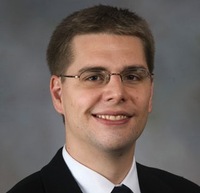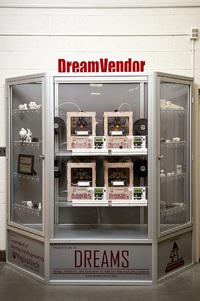 Actually we’re not interviewing the DreamVendor itself; instead we’re interviewing Dr. Chris Williams, the Director of the DREAMS Lab at the Virginia Polytechnic Institute & State University, the organization that produced the DreamVendor. (Wait, what’s a “DreamVendor”??? Read on and you’ll find out.)
Actually we’re not interviewing the DreamVendor itself; instead we’re interviewing Dr. Chris Williams, the Director of the DREAMS Lab at the Virginia Polytechnic Institute & State University, the organization that produced the DreamVendor. (Wait, what’s a “DreamVendor”??? Read on and you’ll find out.) Fabbaloo: We’re wondering what the DREAMS lab is all about? Can you enlighten our readers?
Dr. Williams: The DREAMS Lab is a research lab in the Department of Mechanical Engineering at Virginia Tech. Our research goal is to help transition today’s “rapid prototyping” technologies towards true “additive manufacturing” technologies where they are of a maturity to be considered as viable platforms for manufacturing usable products. We conduct research in three key areas: product design (i.e., designing new (and redesigning current) products specifically for fabrication via AM), process and materials research (i.e., developing new AM processes and materials), and education (i.e., educating future engineers about the potential (and technical challenges) in AM).
 Fabbaloo: Has the lab been experimenting with new 3D printable materials? What materials have been investigated, and what has been found?
Fabbaloo: Has the lab been experimenting with new 3D printable materials? What materials have been investigated, and what has been found? Dr. Williams: As Mechanical Engineers, we tend to collaborate with our friends in the Department of Materials Science and Engineering to investigate new material systems. We have researched several new printable material systems ranging from metals, ceramics, biopolymers, and nanocomposites. Given the material limitations of most AM systems, we often look to combining AM with other processes to create unique material systems. For example, we have developed a process where we 3D Print a polymer pattern that is then coated with a bio-compatible ceramic material via a process called biomimetic mineralization. In this process, the part is placed in a solution that mimics a human’s blood plasma, and small bone-like ceramic crystals deposit automatically onto the part. The resultant part could serve as a tissue scaffold to aid in healing wounds and fractures in bone.
Dr. Williams: The DreamVendor is a “vending machine” powered by four MakerBot Thing-O-Matics. A student begins by loading his/her design (in the form of the MakerBot .s3g toolpath file) onto a SD card. The student loads the SD card into the machine’s control panel, and selects the file to print. Once the print is complete, the part is ejected into a bin to be retrieved. Thanks to funding provided by the Student Engineers’ Council, it’s completely free to use – the only cost is learning how to use it.We didn’t change much about the printers themselves for this project, aside from a few tweaks to the toolpath generation code. The real work went into creating a user-interface and experience that makes 3D Printing more accessible. There’s something comfortable and familiar about using a vending machine interface; but in this situation the inventory of the machine isn’t limited by what’s in the case – the item you want is never out of stock since it’s of your own creation and is made on-demand.Our team built the DreamVendor a few different reasons. The primary reason was to provide students open-access to 3D printing to enable them to turn their ideas into physical products. The VT Department of Mechanical Engineering graduates 300 students a year, and it has always been challenging to provide them with sufficient resources to make products that they have designed for either their class or personal projects. The idea for the DreamVendor came mainly to solve this problem; open-access 3D Printing provides an easy way for our students to make things. The secondary reason was to provide an interactive way to educate students about 3D Printing. In effect, it is part machine shop and part educational display. We have samples of parts created on our other machines on display that truly show the power of 3D printing. The best part, and the biggest surprise, is hearing conversations in the hallway of students using the machine – they might not be aware, but they are actively teaching each other about CAD, 3D Printing, design, and manufacturing.
Fabbaloo: While the DreamVendor is quite an accomplishment, we suspect you’re working on new projects. Can you describe your next 3D printing projects?
Dr. Williams: As always, we’re working on quite a few projects that span several disciplinary boundaries. We’ve been working a lot recently with our Objet Connex machine. The multi-material capabilities of that machine are very interesting; it provides a designer full control over where material is located and the properties of that material. I can make structures that are stiff in some areas, flexible in other areas, and yet, are very lightweight. One of my PhD students, Nick Meisel, is currently looking at ways to make unique compliant mechanisms with this technology – he has even found a way to actuate these structures with shape memory alloys. I have another student, Amy Elliott (featured in the DreamVendor video), who is looking at jetting Objet photopolymers with embedded nanoparticles to enhance a part’s material properties. One of my MS students, David McCarthy, has developed a process to create strong, lightweight structures by combining 3D Printing and metal plating.
The lab has produced two very informative videos that show the DreamVendor in action:
And here’s the second:
Virginia Tech: DREAMS Lab from virginiatech on Vimeo.
For more information you’d best hit the link below. Be sure to check out their rather amazing list of 3D printing equipment, which we believe must be one of the most comprehensive anywhere.
Via DREAMS Lab


